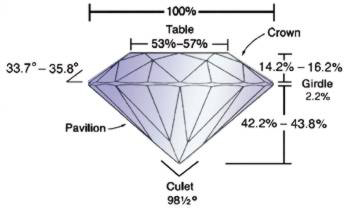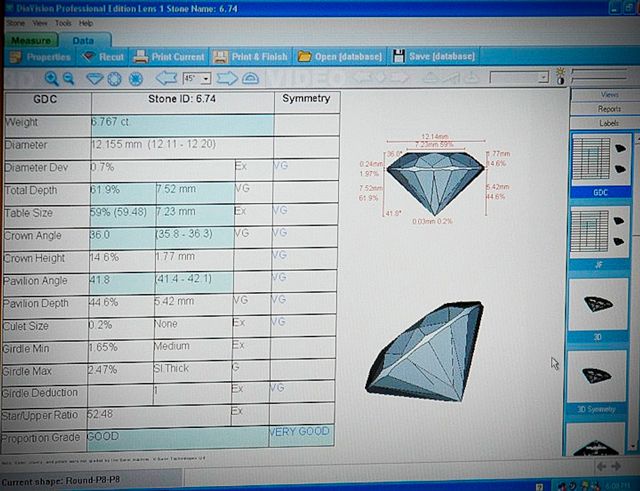Diamond Engagement Ring Appraisal
Diamond Ring Appraisal.
Insurance companies typically request that fine jewelry appraisals be updated every 5 years. Since historically, diamonds have increased in value at a steady pace this practice serves to protect the best interests of each client in the event of a loss.
How the 4 C’s Affect Your Diamond Appraisal

The Ideal Round Cut Diamond
Color – The more colorless your diamond is, the greater its rarity and value. Color is graded on a spectrum with “D” being the highest, whitest grade (please note that fancy colored diamonds are graded on a different scale).
Clarity – In general, the fewer flaws your diamond has can increase the value of the stone; however, value also has a lot to do with the placement and color of each inclusion. Not all flaws impact equally and a skilled appraiser will be able to discern the inclusions impact on the diamond’s value. Many years of experience are required for a diamond appraisal expert to be able to truly know how the quantity, size and position of the inclusions affect value.
Cut – Over time, the words “cut” and “shape” have taken on similar meanings when it comes to diamonds and this is not necessarily correct. The cut of a diamond relates to how the diamond was cleaved and cut – this is the main factor in determining the amount of fire and brilliance that emit from a diamond. Skilled diamond cutters are true artisans. They study each piece of rough (un-cut) diamond before starting in order to select the shape that will maximize the weight and value of the rough material. Again, only a skilled diamond appraiser who has looked at thousands of diamonds under magnification can truly help to determine if a stone is properly cut.
Carat – Diamond weight is measured by metric carats and priced on the markets on a “per carat” basis. The heavier a diamond, the higher the price per carat. Unfortunately, the “price per carat” reality provokes most diamond cutters to produce heavier-cut material rather than truly focusing on properly cutting each diamond to maximize fire and brilliance. Diamond value is also affected by the overall carat weight relative to face size, cut and brilliance.
In addition to the 4 Cs, experienced diamond appraisers will also take into consideration these factors:
- How rare is the stone and how easy or difficult would it be to replace?
- What is the quality of the diamonds used in the setting?
- What is the quality of the ring’s craftsmanship?
- Does the diamond have fluorescence and, if so, what level?
Retail vs. Replacement Value of Your Diamond
To properly interpret your diamond appraisal you will also need to know if the value is a “retail value” or “retail replacement value.” The difference between the two is important… most insurance companies and diamond laboratories recommend using a retail replacement. This is the amount that insurance companies like to see because it states what would be needed to replace the piece with one of equal quality in today’s market. Retail values tend to be exorbitantly high and result in the insured over-paying in premium for a value that they will never receive anyway if the ring is lost or stolen.

Certified Graduate Gemologists
Finding the right laboratory to appraise your jewelry is a lot like when you purchase a diamond or fine jewelry – select one whom you trust and who truly specializes in the product that you are asking to have appraised. Certified graduate gemologists or graduate graduate appraisers, like those with the American Diamond Laboratory, can give you a detailed, accurate report as well as explain to you how they arrived at the valuation amount of your engagement ring or fine jewelry